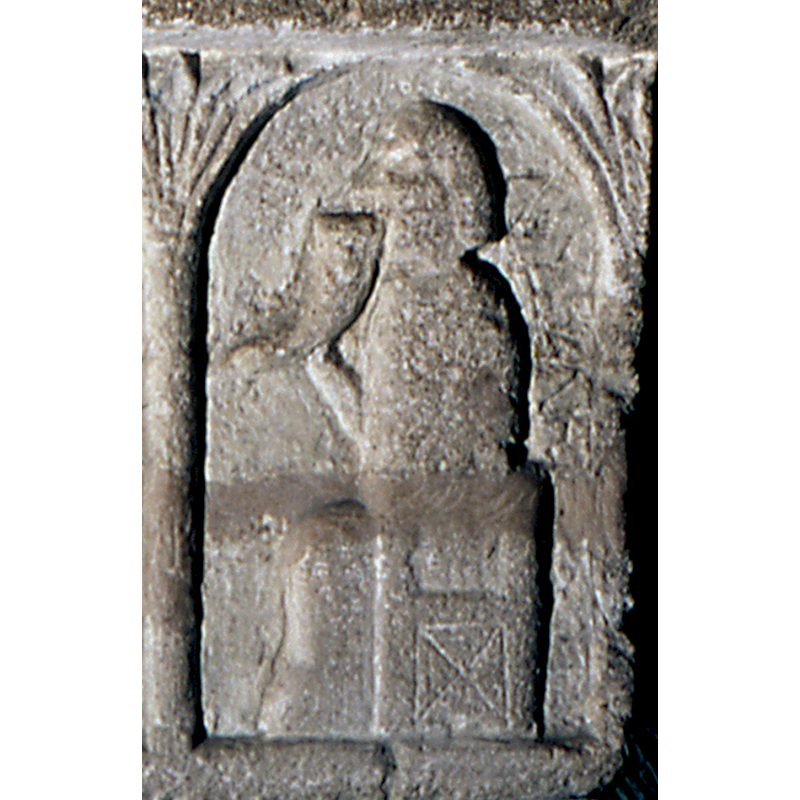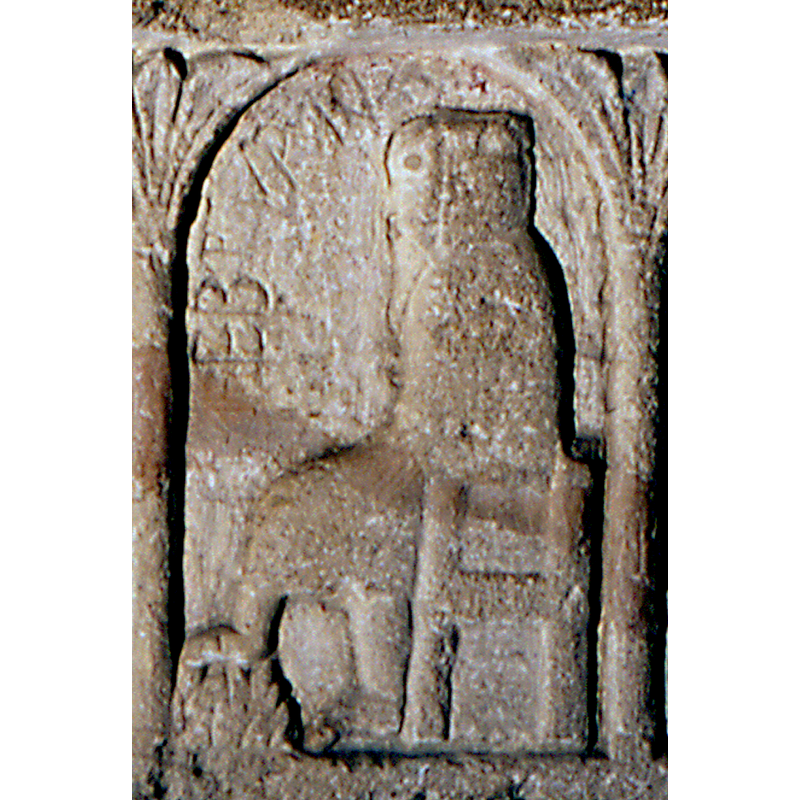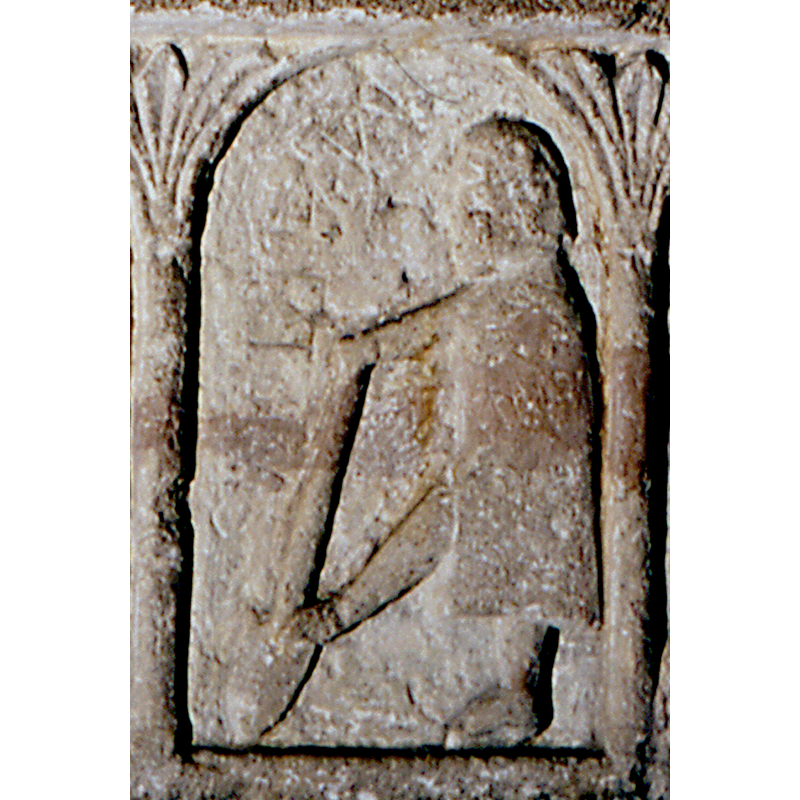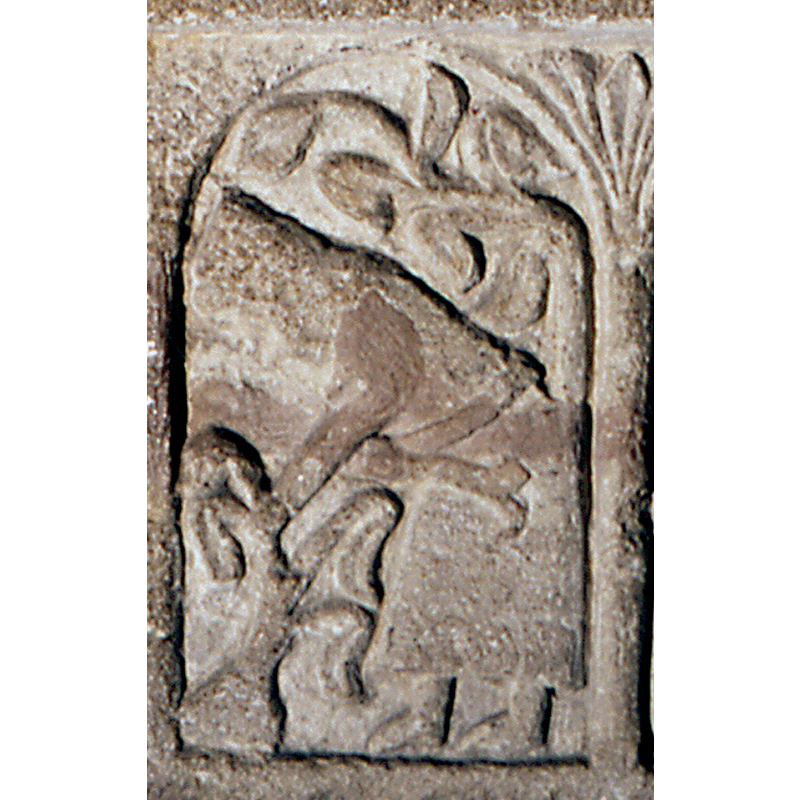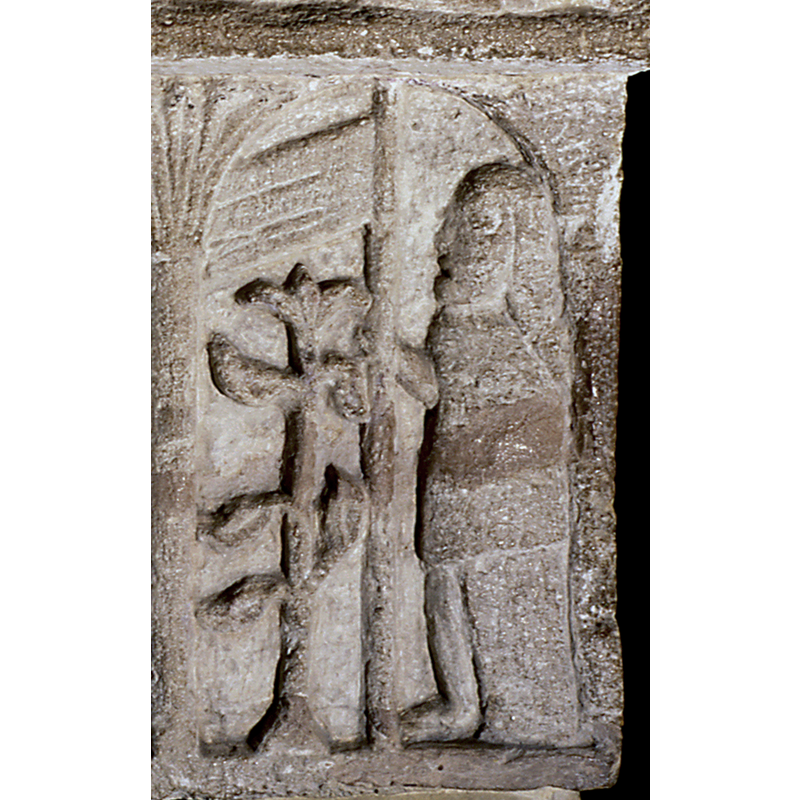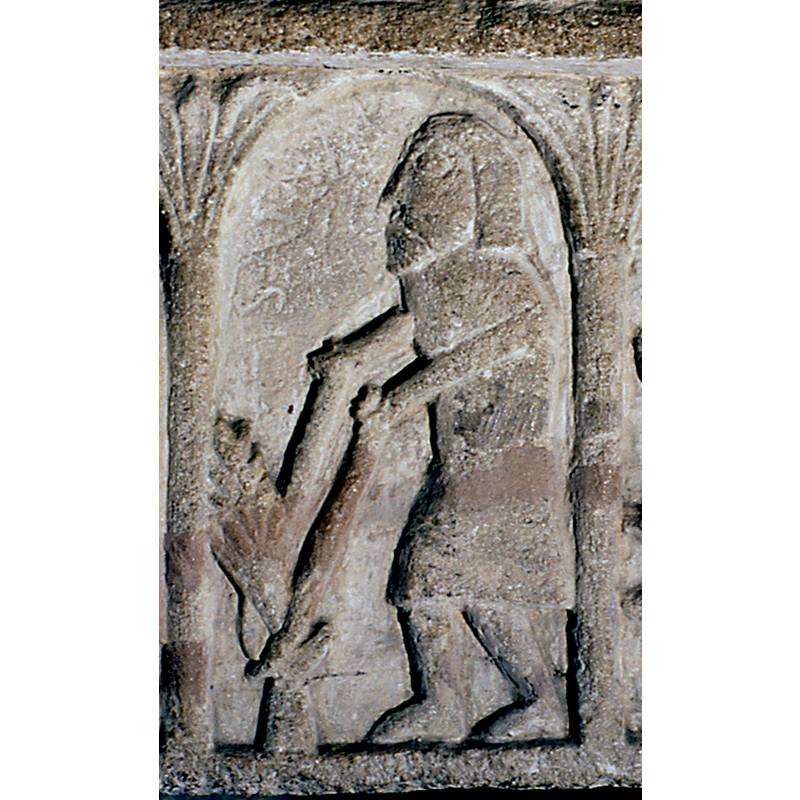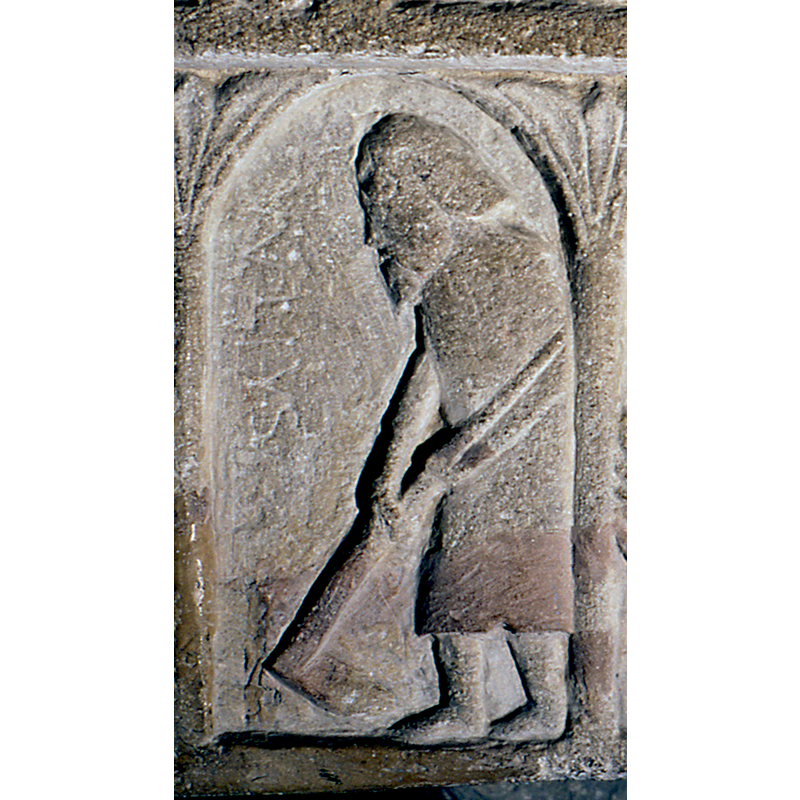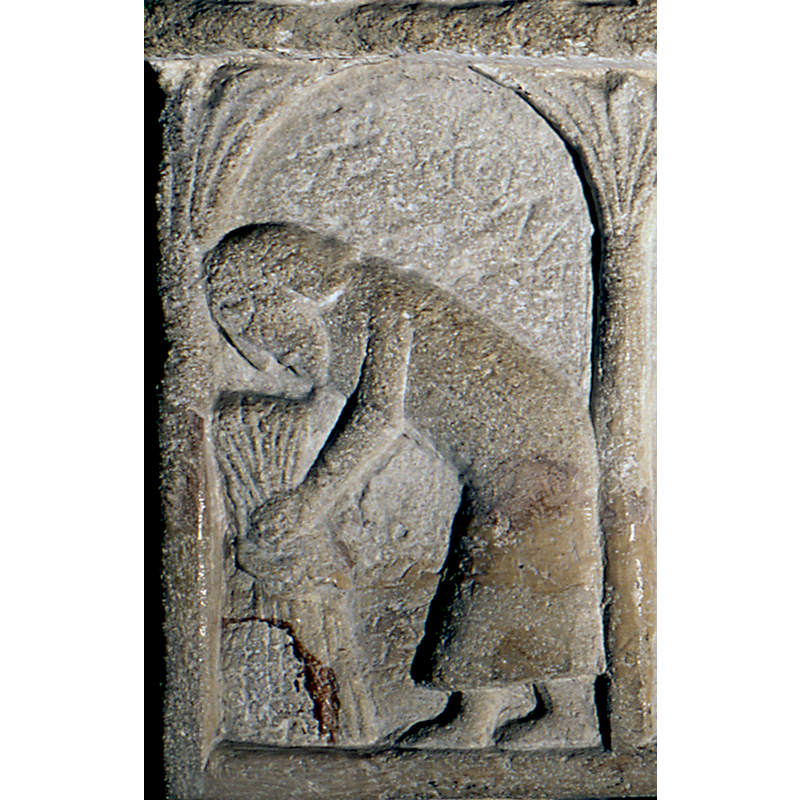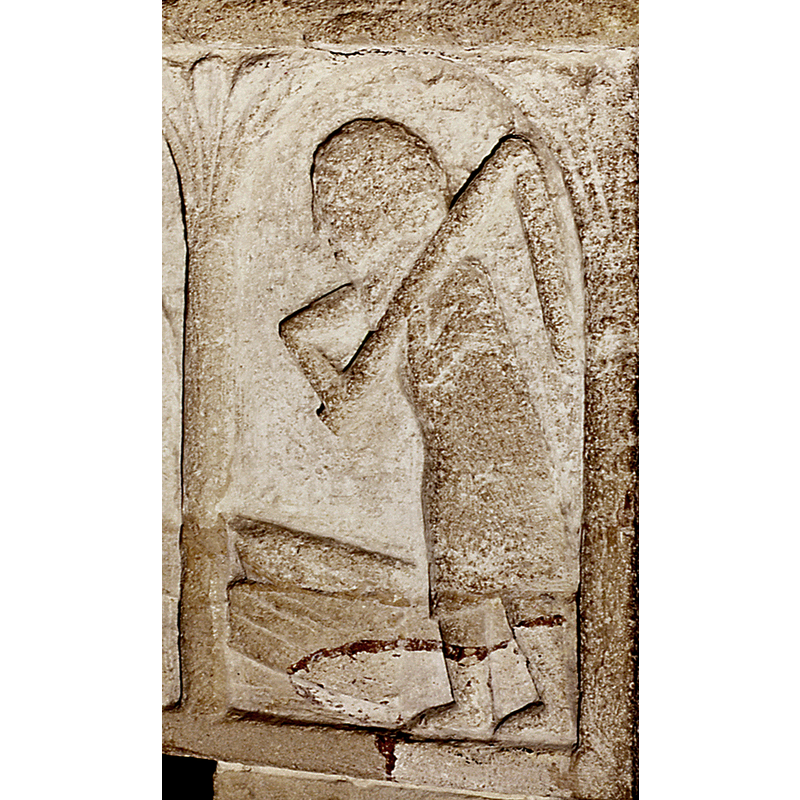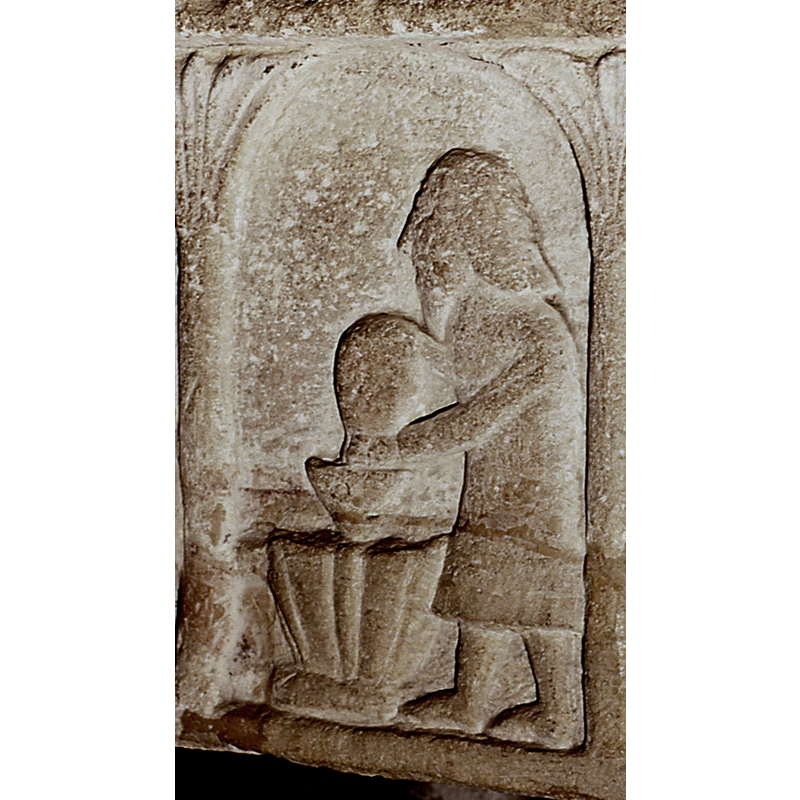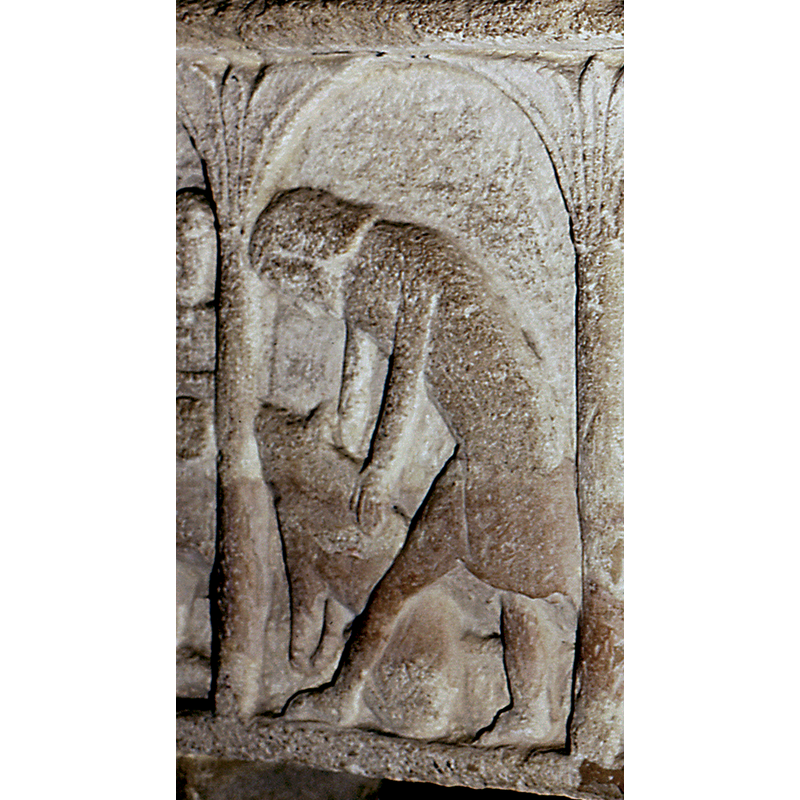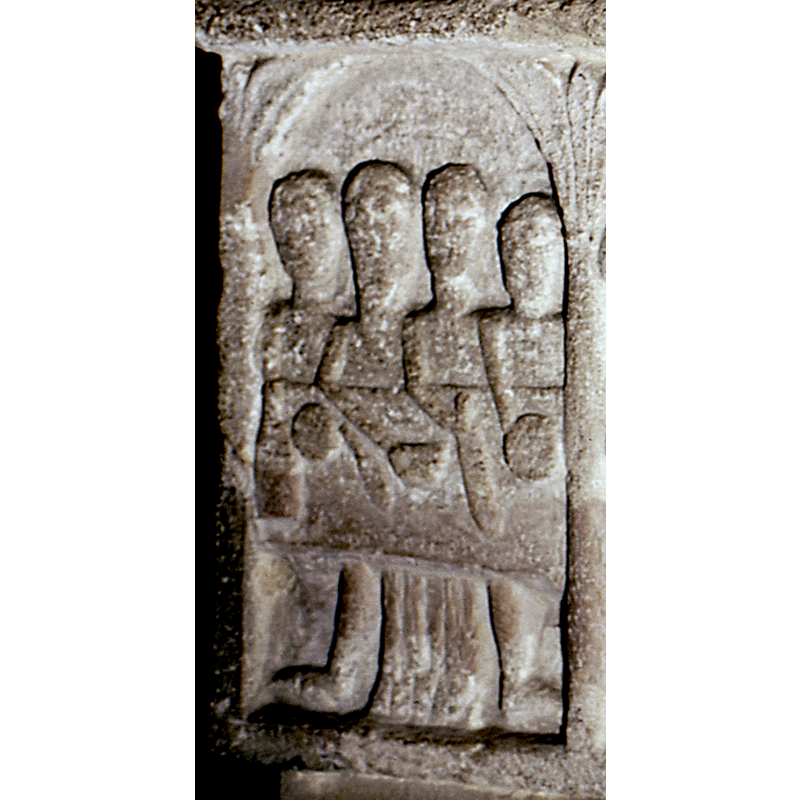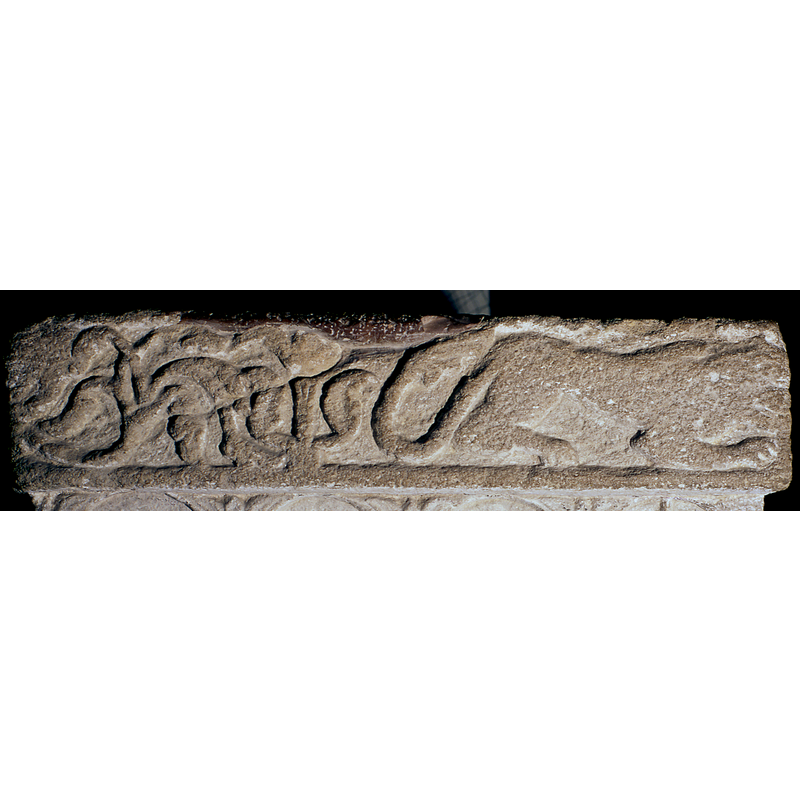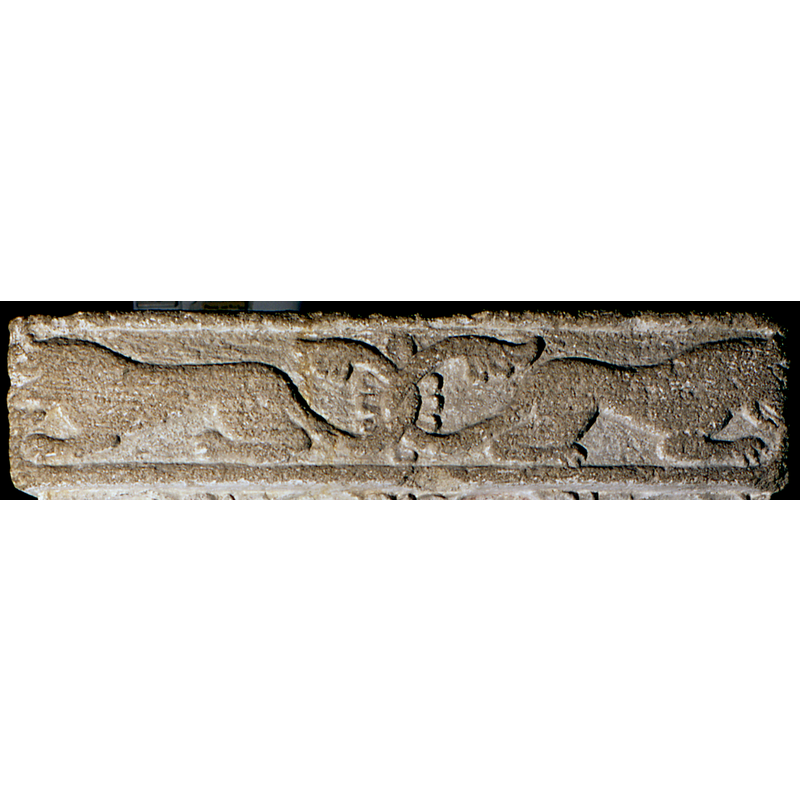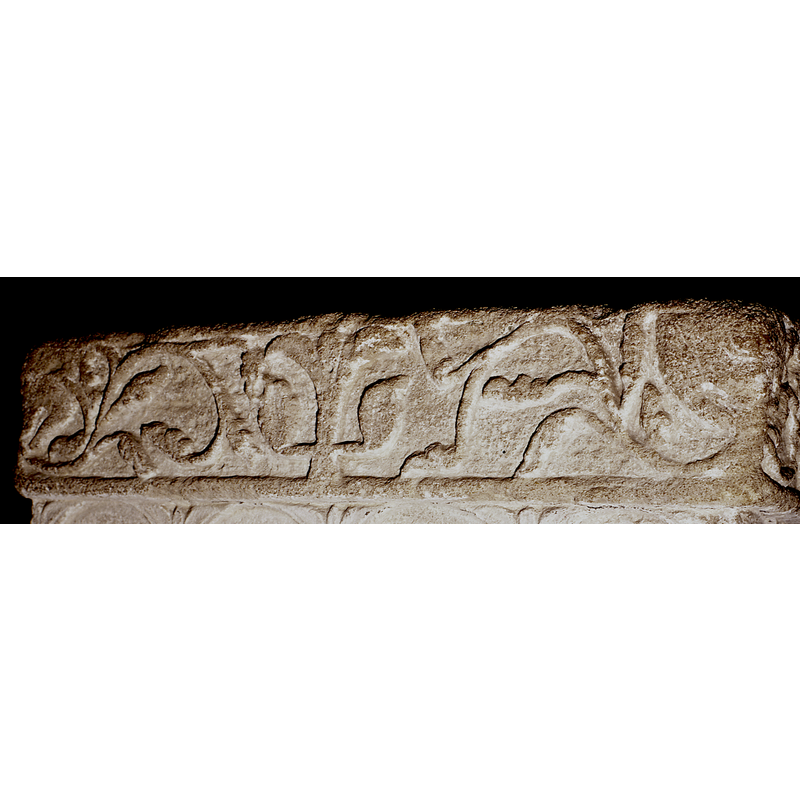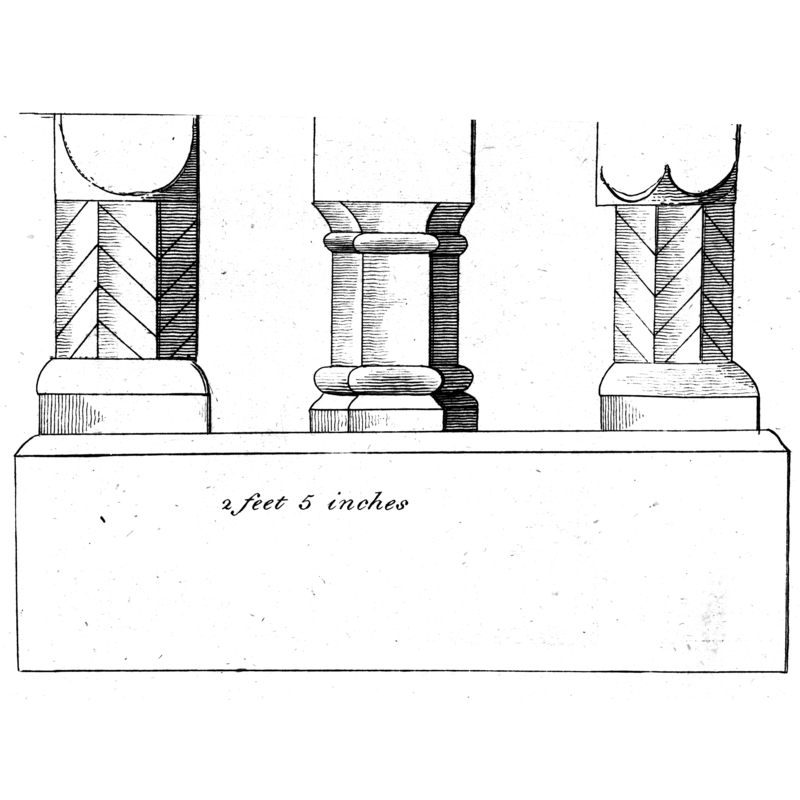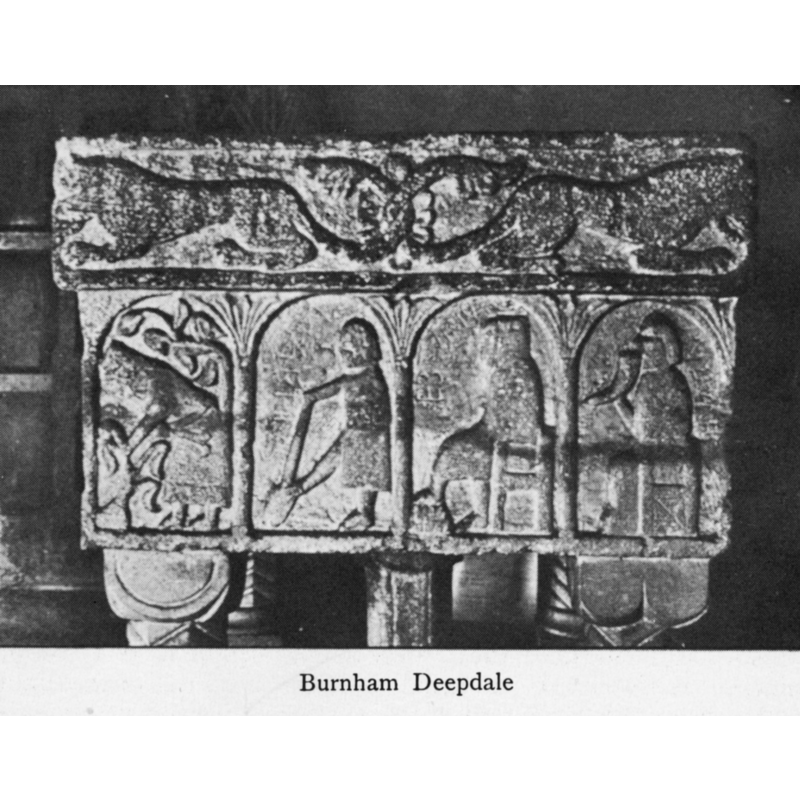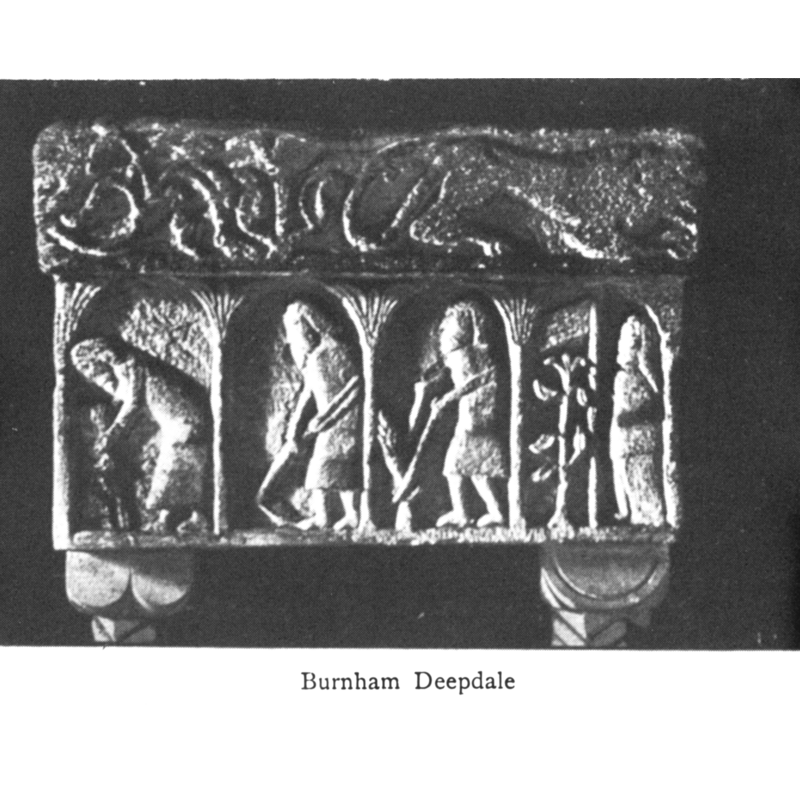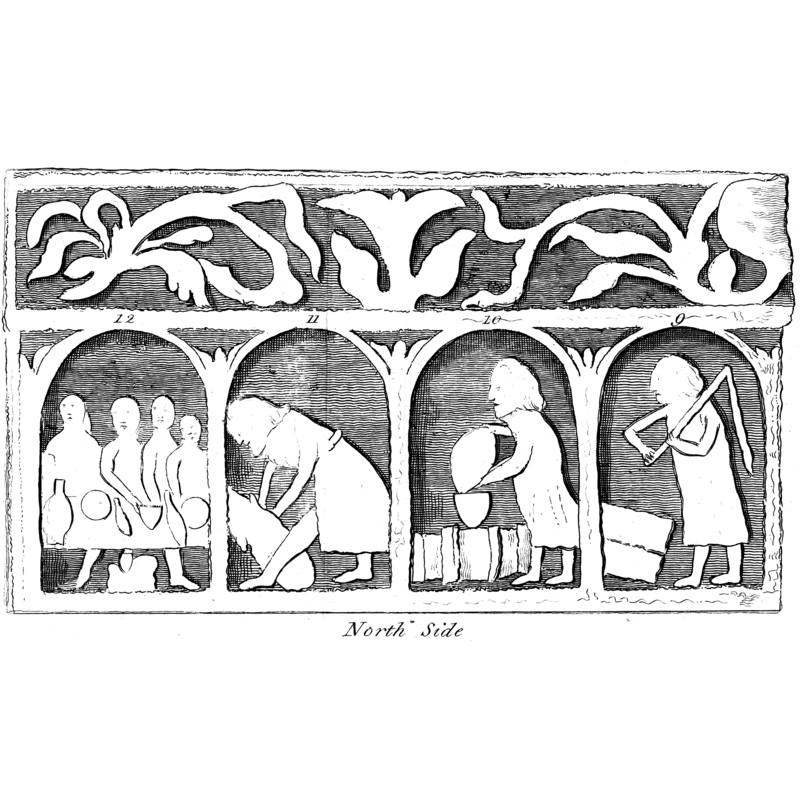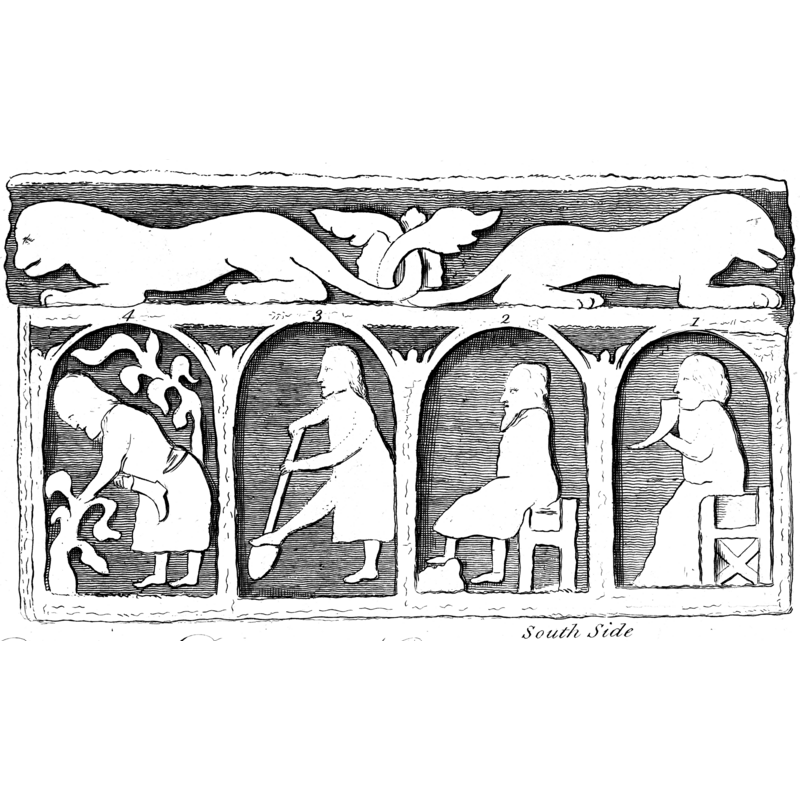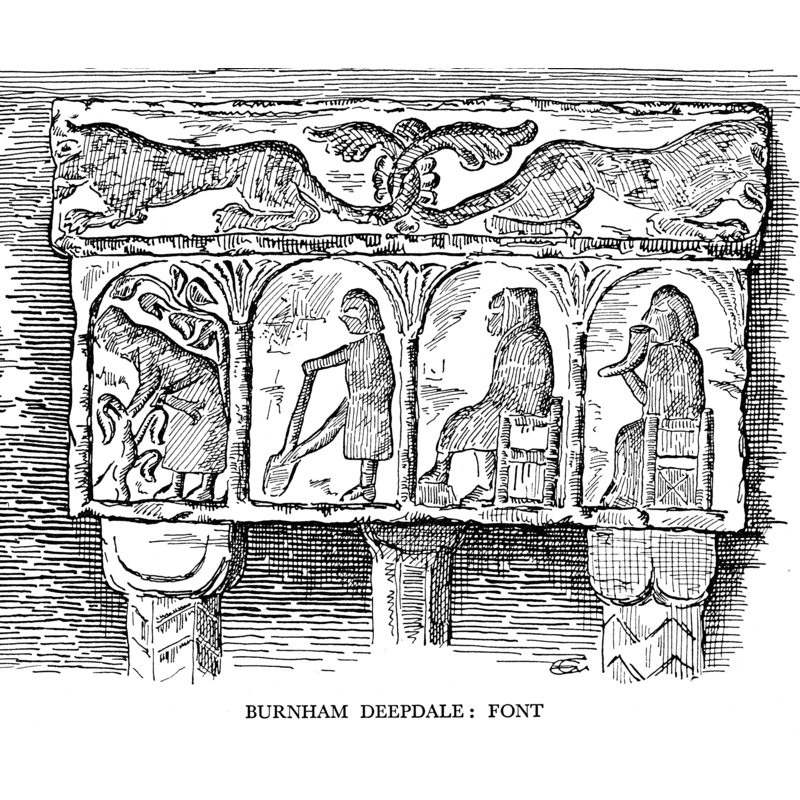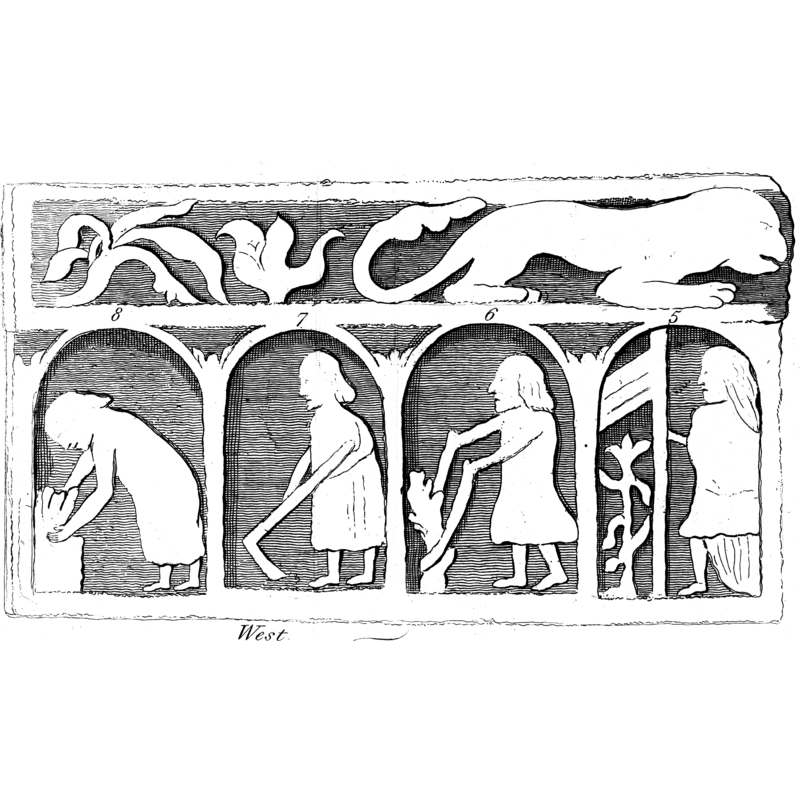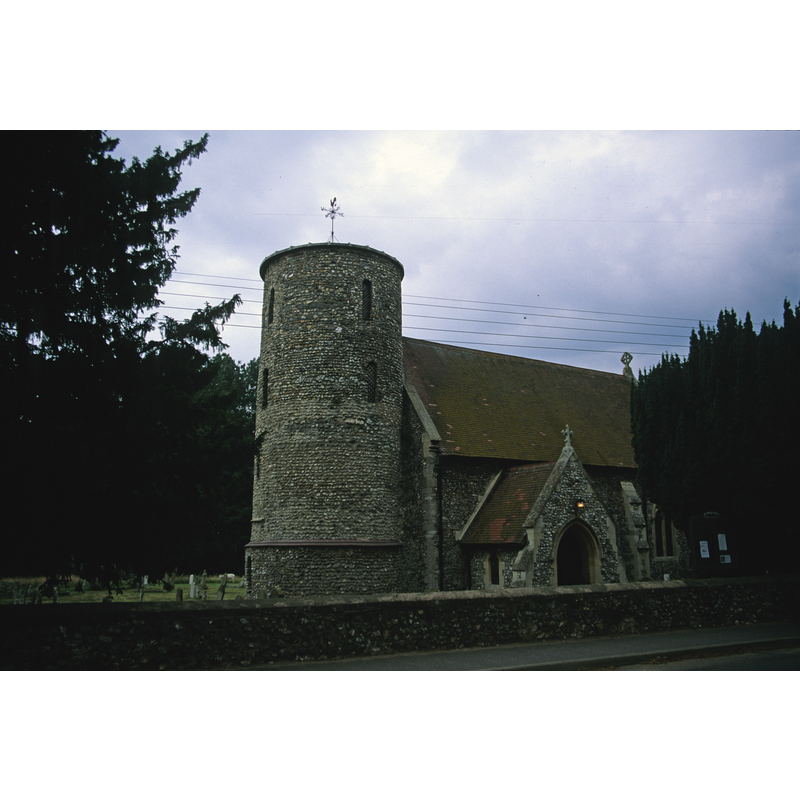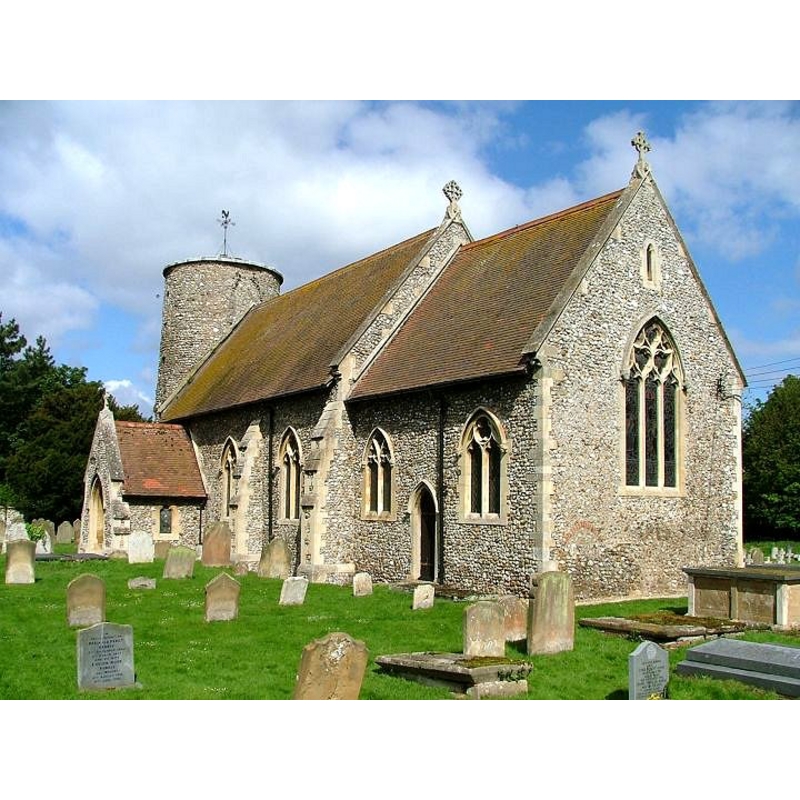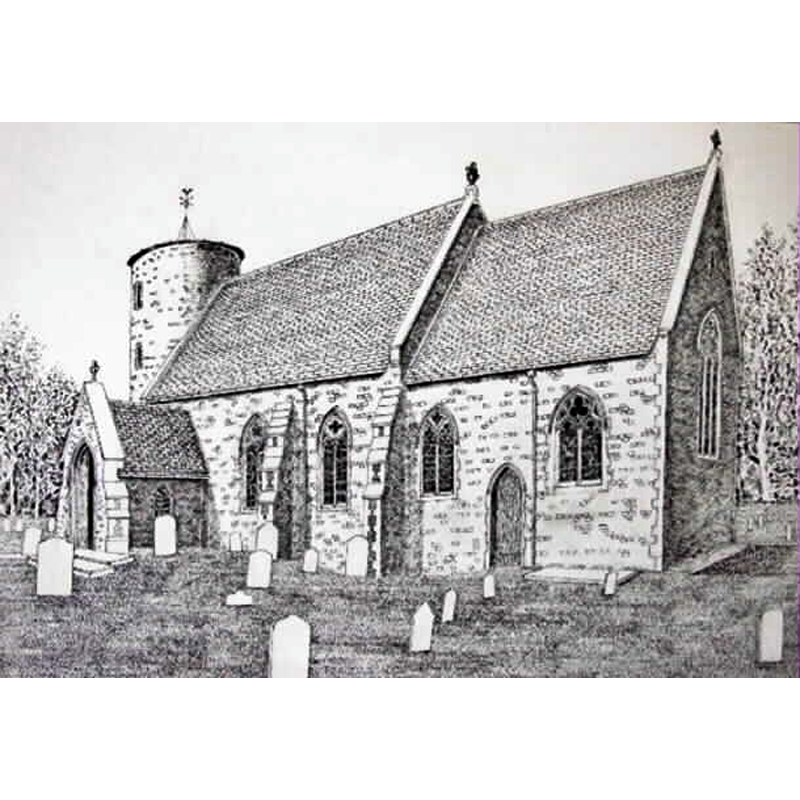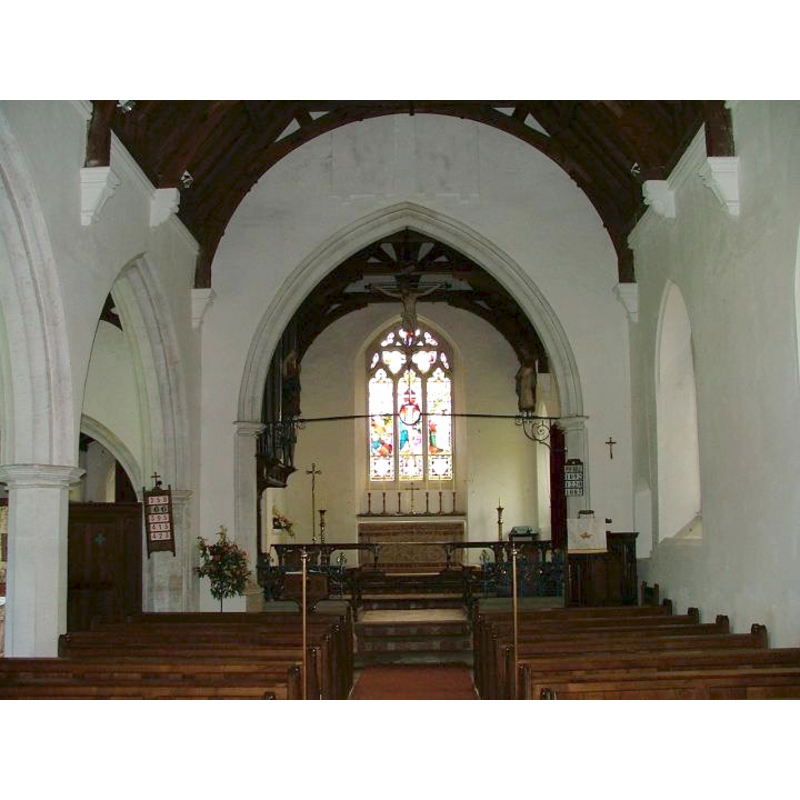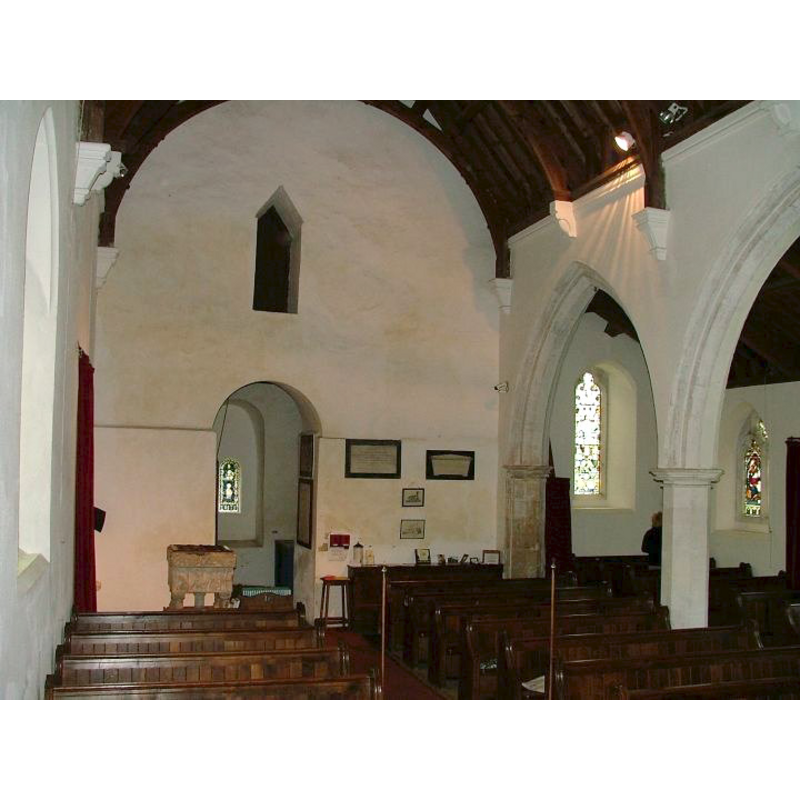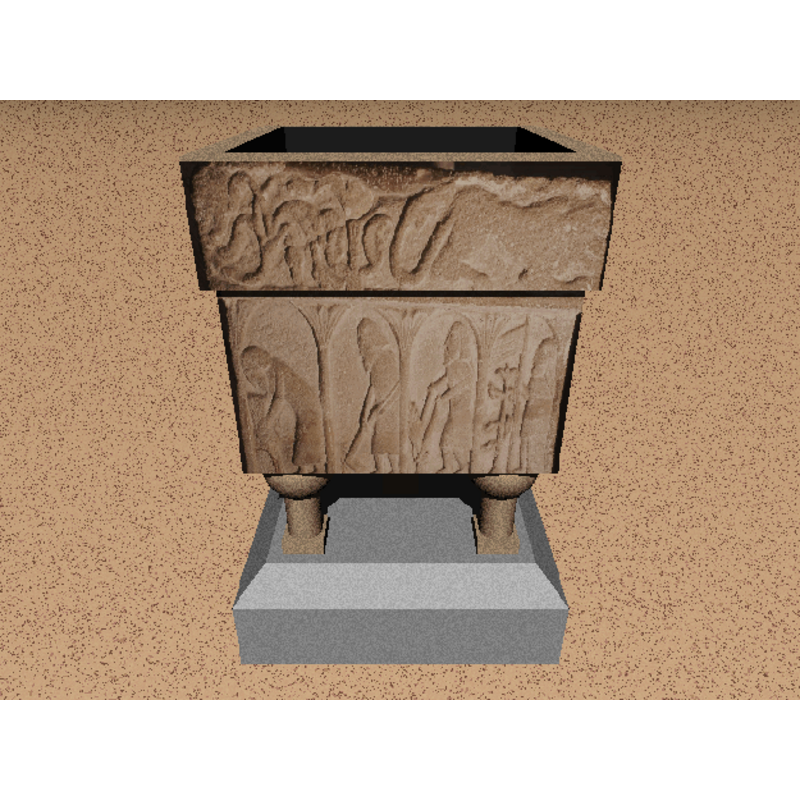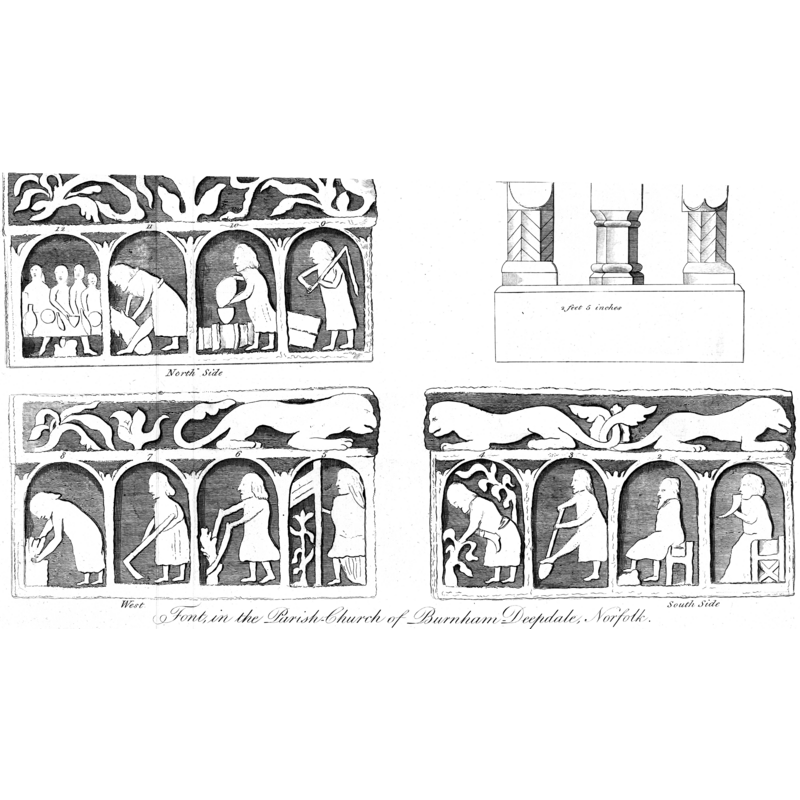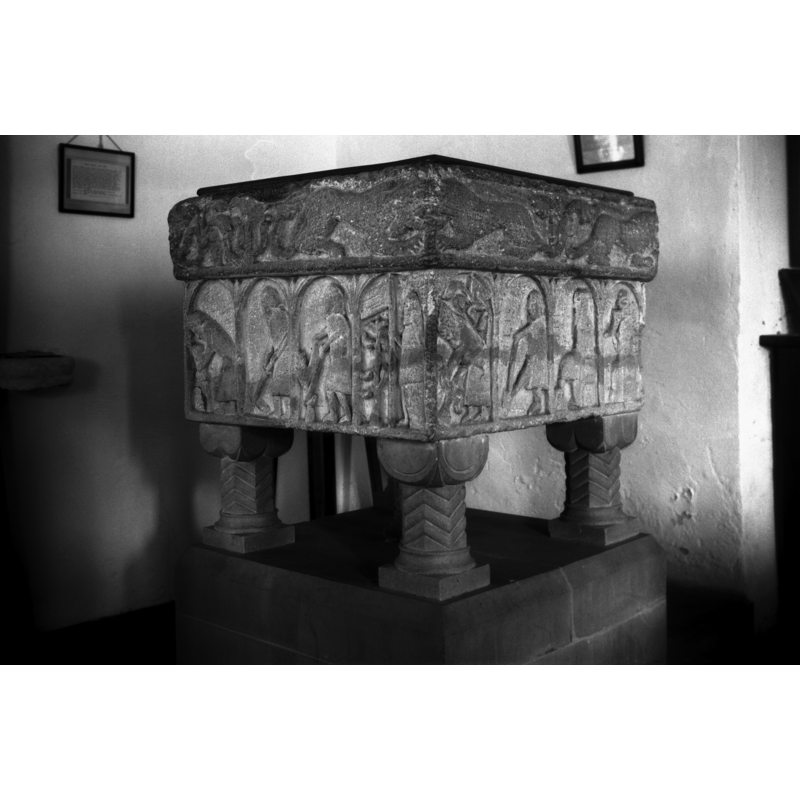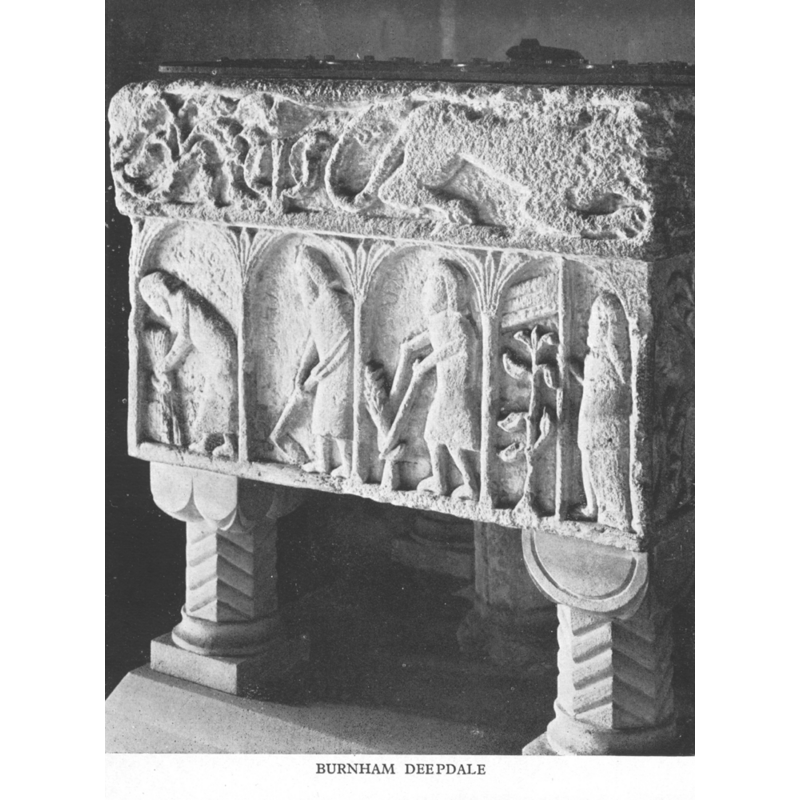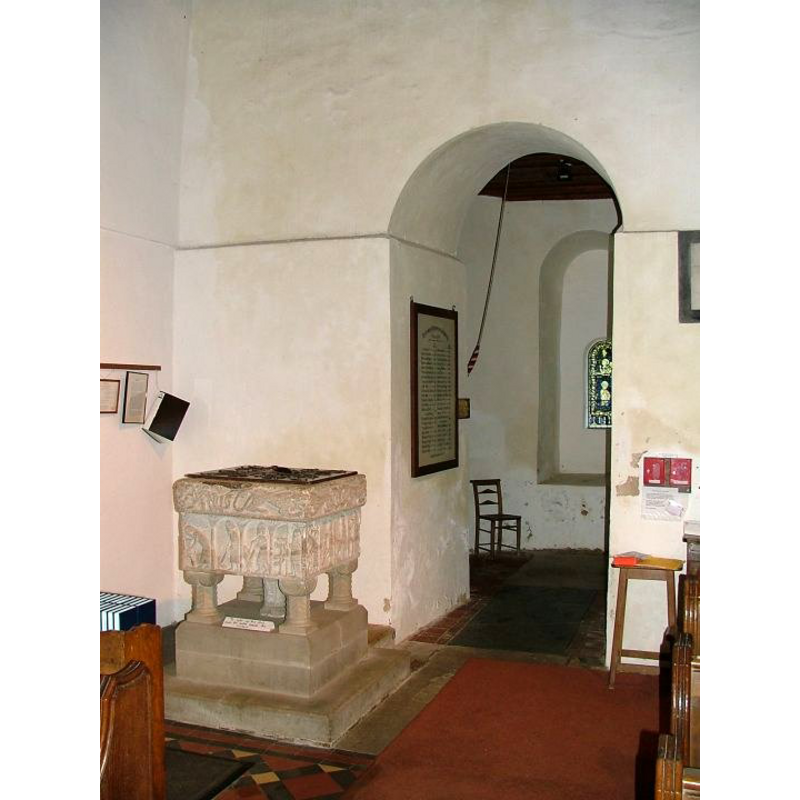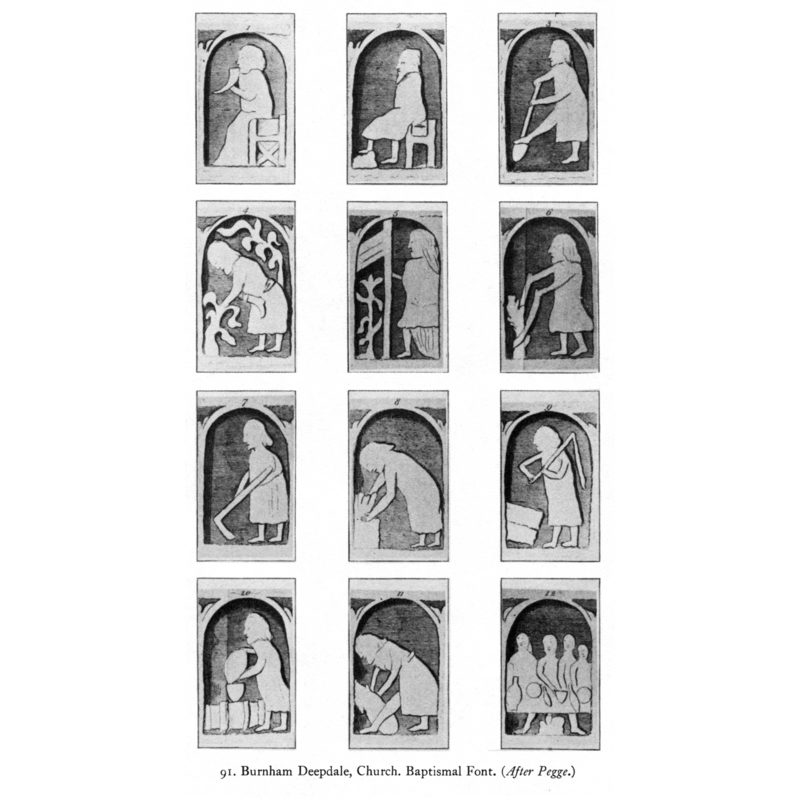Burnham Deepdale / Bruneham / Burnham Deepden / Burnham Depedale / Depeden
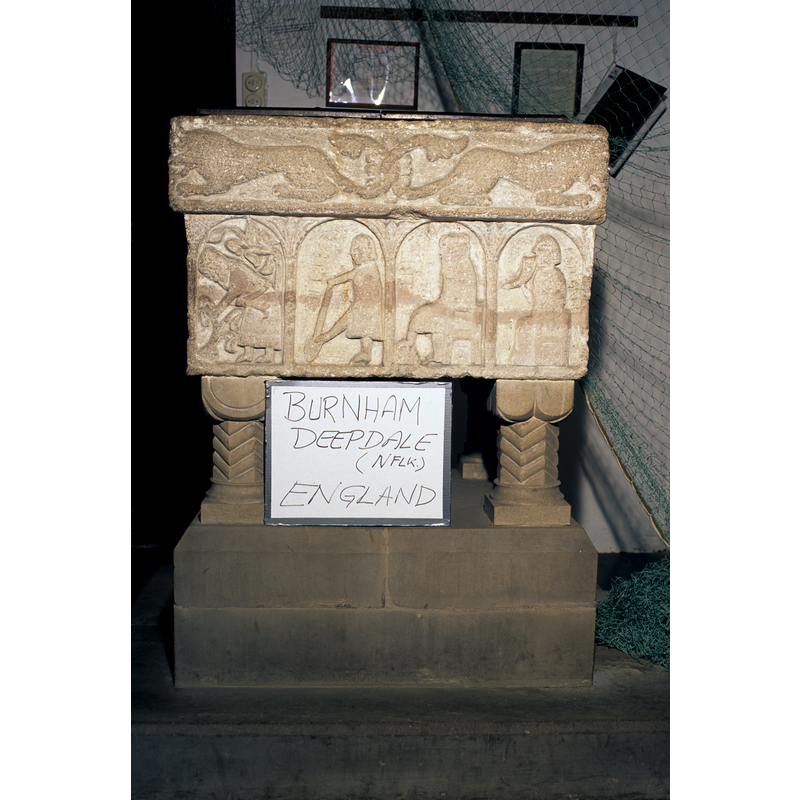
Image copyright © Baptisteria Sacra Index, 2023
Results: 36 records
B01: nature - labours of the months - January - man with drinking horn
B02: nature - labours of the months - February - man sitting on stool and warming his feet
B03: nature - labours of the months - March - man digging in the garden
B04: nature - labours of the months - April - man pruning a plant
B05: nature - labours of the months - May - man holding Rogationtide banner
B06: nature - labours of the months - June - man weeding the garden
B07: nature - labours of the months - July - man with hoe
B08: nature - labours of the months - August - man harvesting grain and binding a sheaf
B09: nature - labours of the months - September - man threshing corn
B10: nature - labours of the months - October - man pouring liquid from bottle into a vat - wine making
B11: nature - labours of the months - November - man about to slaughter a pig
B12: nature - labours of the months - December - the feast
animal - mammal - lion - passant - facing right
animal - mammal - lion - passant - linked at the tails - 2
design element - motifs - foliage
view of base - detail
view of basin
view of basin
view of basin
view of basin - north side
view of basin - south side
view of basin - south side
view of basin - west side
view of church exterior
view of church exterior - southeast view
view of church exterior - southeast view
view of church interior - nave - looking east
view of church interior - nave - looking west
Scene Description: the font to the left side (south) of the tower arch
Copyright Statement: Image copyright © Simon Knott, 2005
Image Source: digital photograph May 2005 taken by Simon Knott [www.norfolkchurches.co.uk/burnhamdeepdale/burnhamdeepdale.htm] [accessed 4 June 2013]
Copyright Instructions: Standing permission
view of font
view of font
view of font - drawing
view of font - northeast side
Copyright Statement: Image copyright © George Plunkett, 2015
Image Source: B&W photograph taken 14 September 1977 by George Plunkett [www.georgeplunkett.co.uk/Norfolk/B/Burnham Deepdale St Mary's Norman font NE [5864] 1977-09-14.jpg] [accessed 16 October 2015]
Copyright Instructions: Standing permission by Jonathan Plunkett
view of font - south side
view of font - west side
view of font and cover in context
Scene Description: in the southwest corner of the nave
Copyright Statement: Image copyright © Simon Knott, 2005
Image Source: digital photograph May 2005 taken by Simon Knott [www.norfolkchurches.co.uk/burnhamdeepdale/burnhamdeepdale.htm] [accessed 4 June 2013]
Copyright Instructions: Standing permission
INFORMATION
FontID: 00214BUR
Object Type: Baptismal Font1
Church/Chapel: Parish Church of St. Mary
Church Patron Saints: St. Mary the Virgin
Church Location: Burnham Deepdale, Norfolk, PE31 8DD
Country Name: England
Location: Norfolk, East Anglia
Directions to Site: Located in the North Norfolk Heritage Coast, up the B1355 from Fakenham or the A149 from King's Lynn
Ecclesiastic Region: Diocese of Norwich
Historical Region: Hundreds of Gallow and Brothercross
Font Location in Church: Inside the church, at the W end, S side of nave [previously in the N side -- cf. FontNotes for details of the move]
Century and Period: 11th century [Webster] / 12th century, Norman
Workshop/Group/Artisan: West Norfolk group
Cognate Fonts: A sister font, now badly mutilated, is still at Warham All Saints [cf. Index entry for Warham All Saints No. 1]
Credit and Acknowledgements: We are grateful to Simon Knott, of Norfolk Churches [www.norfolkchurches.co.uk], for his information on and photographs of this church and font. We are also grateful to John Wilkes, of www.allthecotswolds.com, for his digital reconstruction test image of this font, and to his brother, Robert Wilkes. for his drawing of this church. We are also grateful to Jonathan Plunkett for the photographs of this church, taken by his father, George Plunkett, in September 1977
Font Notes:
Click to view
There is no mention of church or priest in the Domesday entry for "Bruneham". The font here is described with an illustration "by a young gentleman" in Pegge (1792) as: "a most curious and singular antient laver [...]; the sculpture of the figures is so mean and rude as unquestionably to bespeak of very remote amtiquity; but whether the performance can be thought to rise higher than the Norman area may, perhaps, be justly doubted"; Pegge follows with a detailed description of each of the scenes by a Mr. Crowe [cf. infra], with some additional comments of his own. In his entry for this parish Blomefield (1805-1810) writes: "The Church is dedicated to St. Mary, and is a rectory [...] The church has a nave, a north isle, and a chancel covered with lead [...] Here is an old font, standing on five pillasters, a round tower, with one bell". Blomefield (ibid.) further notes: "There was a controversy between William, abbot of Ramsey, and Godfrey the priest, concerning this church, terminated by Gilbert Foliot Bishop of London, in the reign of Henry II." [NB: Foliot became bishop of London in 1163. Henry II's reign dates are 1154-1189]. The font is noted in Poole (1842), with reference to "Archaeologia, x, 189". Pugin (1843) writes of the "different labours of the husbandman" as a symbolic representation of "the processess of the vineyard, by which the good works of Christians were symbolized in Italy and other vine countries". Livett (1905) refers to Pegge [supra] and adds: "The Rev. Henry Crowe, 'the worthy and sagacious rector of Burnham', in 1799, describes the MAY labour of the Deepdale font in the following terms: 'A female figure with long hair, having a banner in her hand. Before her a tree in full foliage, an emblem of the month.' And he [Crowe] adds, 'May it not allude to the perambulation?' [...]" Described and illustrated in Bond (1908). Square bowl with arcade motif on the sides in which the scenes of the months are represented: January shows a man carousing; February, a man warming himself; March, a man digging; April, a man pruning a plant; May, a woman carrying a flag in the processions at Rogation Tide; June, weeding; July, a man mowing; August, a man binding a sheaf; September, a man threshing; October, a man barrelling wine; November, pigsticking; December, four people sit a table for Christmas dinner; a wide band between the rim and the scenes depicts felines, some with their tails intertwined. As the web site for the Saxonshore benefice points out, "the months run anticlockwise so that one walks around it with the sun and not against it which be 'widdershins', against nature, the devil would be waiting!". This same source informs that "The font was damaged when moved from the North aisle of the church at Burnham Deepdale in 1797 and was taken to Fincham for repair [...] It stayed there in the garden of the Rectory for forty years before it was finally restored and placed in its present position. The font is made of Barnack stone from Rutland". [source: www.saxonshorebenefice.fsnet.co.uk]. [NB: Guilford (1927), among others, notes a set of stones with the months of the year topic at Calverton St. Wilfrid's, in Nottinghamshire]. Described in Tyrrell-Green (1928) as "remarkable". The 'labours of the months' program on this font is studied and catalogued in detail in Webster (1970 c1938), who points out that Liwett [i.e., Livett (1905)] errs in stating that the names of the months are repeated as on the Brookland font. Webster (ibid.) dates the Burnham Deepdale font to the 11th century. Listed and illustrated in Cautley (1949) who describes it as "probably the most interesting font in England". Pevsner & Wilson (1999) date the basin to the early-12th century and the "piers under the bowl are C19". Described and illustrated in Kroesen & Steensma (2004). Illustrated in Simon Knott's Norfolk Churches (2005, 2006) with some interesting notes: "It is interesting that four of the panels, January, February, November and December, show leisure activities. The subject of November's panel is, perhaps, a curious one to find on a Norfolk font; if this had been Lincolnshire, of course, we wouldn't be surprised at all. I did wonder if perhaps an alternative interpretation, that this shows a pig being slaughtered, might be possible. However, will evidence seems to support the notion that pig-shagging was a popular activity even outside of the Fens in medieval times; a 1480 will in neighbouring Brancaster leaves one marke for a candle to burne before Our Ladyes rowelle for ever and a carucate of land in the manor of Staithe for the layeing out of ground for the shagging of hogges, which, excitingly, suggests that pig-shagging was not the solitary activity we might imagine, but corporate, celebratory, and possibly even competitive (see postscript) [cf. infra]. That the font has survived in such good condition is fortunate. During the late 18th century, at the time of the first great restoration, it was moved out of an aisle which was to be demolished. In being moved, it was dropped, and broken into several pieces. The bits were discarded, ending up in a rockery at Fincham, thirty miles away. An elegantly classical birdbath font took its place; you can see it today in the sanctuary at nearby Titchwell. It was only when the aisles were rebuilt some seventy years later at the time of a renewed fascination with anything medieval that the pieces were returned here, stuck back together, and the font given its current home at the west end of the south aisle. It was mended very well - you can just make out that the lower part of the October panel is a modern restoration [...] Postscript, March 2006: having received a number of e-mails on the subject of the November panel of the font, I decided to seek an expert opinion. Joseph Orton, Professor of Medieval History at the University of Leicester, and author of Real Men of Norfolk: Male-Bonding and the Construction of Patriarchy in Late Medieval Agricultural Practices, writes: 'Pig-shagging is best understood as a lost art, once vital to a rural medieval economy, but now no longer recognised or practiced. It concerned the close relationship of a peasant with his pig that ultimately enabled the pig to be used to seek out and notify the existence of hidden or buried objects, usually food. Today, we associate this skill with the truffle-hunters of the Dordogne, but in a medieval English winter such an animal might extend the household food stores by detecting unharvested roots and tubers. It was effectively the domestication of a pig to carry out a household role. The training of a pig in this way, as well as the performance of its duties, was a social occasion, and seems to have been regarded as a spectacle in contemporary accounts, but this may simply reflect the paucity of the other early-winter entertainments available to late-Medieval man. Interestingly, from the same Anglo-Germanic roots, the word Schag has come down to us in Afrikaans, referring to a South African halter, or bridle, used to tame Zebra on the veldt'." On-site notes: the basin is mounted on one central column (original) and four later-date columns at each corner form the base; on the western side of the basin there is a blind arcade; on the north side (moving from right to left) there are four months of the year: January, February, March, April; on the eastern side the months continue with May, June, July, August; on the southern side are scenes depicting September, October, November and, lastly, December, all sitting down for the big feast! The inner well of the basin is lead lined and there is a central drain; the months not labelled but February, with a hooded man warming his feet by the fire, has several capital letters crudely incised on it, the F, E, B and A are clearly discernible, and they appear to spell the name of the month; a few other panels have also been incised with letters, unfortunately less successfully; all these incisions are believed to have been added at a later date.
COORDINATES
Church Latitude & Longitude Decimal: 52.966056, 0.685341
Church Latitude & Longitude DMS: 52° 57′ 57.8″ N, 0° 41′ 7.23″ E
UTM: 31U 344552 5871002
MEDIUM AND MEASUREMENTS
Material: stone, Barnack stone (from Rutland)
Font Shape: square (mounted)
Basin Interior Shape: round
Basin Exterior Shape: square
Drainage Notes: Lead lining
Rim Thickness: 8-10 cm to 25 cm
Diameter (inside rim): 61 cm
Basin Depth: 35 cm
Height of Basin Side: 49 cm
Basin Total Height: 49 cm
Height of Base: 60 cm (includes the lower plinth)
Font Height (less Plinth): 109 cm
Font Height (with Plinth): (second plinth is 15 cm)124 cm
Square Base Dimensions: 81 x 81 cm
Trapezoidal Basin: 79 x 82 cm
Notes on Measurements: BSI on-site
INSCRIPTION
Inscription Notes: a few letters [F E B [...] A, etc.] are incised in the February panel
Inscription Location: in the February panel, hooded man seating by the fire
Inscription Text: [FEBRUARY?]
LID INFORMATION
Date: modern
Material: wood
Apparatus: no
Notes: flat wooden cover with metal ring-handle and reinforcements
REFERENCES
Allen, J. Romilly, "Notes on Early Christian Symbolism", N.S., VI, Proceedings of the Society of Antiquaries of Scotland, 1884, pp. 380-464; p. 432
Blomefield, Francis, An essay towards a topographical history of Norfolk, 1805-1810
Bond, Francis, Fonts and Font Covers, London: Waterstone, 1985 c1908
Cautley, Henry Munro, Norfolk Churches, Ipswich: Norman Adlard & Co., 1949
Davies, J.G., The Architectural Setting of Baptism, London: Barrie and Rockliff, 1962
Friar, Stephen, The Sutton Companion to Churches, Thrupp, Stroud (Gloucs.): Sutton Publishing, 2003
Gough, Richard, "Description of the old font in the Church of East Meon, Hampshire, 1789: with some observations on fonts", X, Archaeologia, 1792, pp. 183-209; p. 185
Guilford, Everard Leaver, Nottinghamshire, London: Methuen, 1927
James, M. R., Suffolk and Norfolk, London, Toronto: Dent & Sons, 1930
Knott, Simon, The Norfolk Churches Site, Simon Knott, 2004. [standing permission to reproduce images received from Simon (February 2005]. Accessed: 2009-07-20 00:00:00. URL: www.norfolkchurches.co.uk.
Kroesen, Justin E.A., The Interior of the medieval village church = Het middeleeuwse Dorpskerkinterieur, Leuven: Uitgeverij Peeters, 2004
Livett, G.M., "The Leaden Font at Brookland", 27 (1905), Archaeologia Cantiana, 1905, pp. 255-261; p. 259-261
Nordström, Folke, Mediaeval Baptismal Fonts: An Iconographical Study, Stockholm: Universitetet i Umeå, 1984
Paley, Frederick Apthorp, Illustrations of Baptismal Fonts, London, UK: John van Voorst, 1844
Pegge, Samuel, "Observations on an antient font at Burnham Deepdale, in Norfolk", X, Archaeologia, 1792, pp. 177-182; p. 177-182 and pl. XIX
Pevsner, Nikolaus, Norfolk 2: North-West and South (2nd ed.), London: Penguin, 1999
Poole, George Ayliffe, The Appropriate Character of Church Architecture, Leeds; London: T.W. Green; Rivington, Burns, and Houlston and Stoneman, 1842
Prior, Eduard S., An Account of Medieval Figure-Sculpture in England, Cambridge: Cambridge University Press, 1912
Pugin, Augustus Northmore Welby, The Present State of Ecclesiastical Architecture in England, London: Charles Dolman, 1843
Ruprich-Robert, V., Architecture normande aux XIe et XIIe siècles en Normandie et en Angleterre, Paris: Libraririe des imprimeries réunies, 1884-1889
Tyrrell-Green, E., Baptismal Fonts Classified and Illustrated, London: Society for Promoting Christian Knowledge: The Macmillan Co., 1928
Webster, James Carson, The Labors of the months in antique and medieval art to the end of the twelfth century, New York: AMS Press, 1970 c1938
